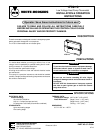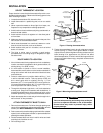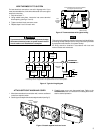
SWITCH POSITIONS SYSTEM FUNCTION
COMPONENT OPERATION
Aux
Heat
Relay
Rev
Valve
(O)
Fan
Relay
Compr.
ContactAuto On Cool Off Heat Emer
FAN SYSTEM
No heat - no cool - no fan - no lights
Heating Mode: stage 1 calling. Fan relay,
compressor contactor, and reversing valve (B)
energized by thermostat.
Heating Mode: both stages calling. Fan relay,
compressor contactor, reversing valve (B),
and auxiliary heat relay are energized.
Emergency Heat Mode: aux heat, Fan Relay*
and reversing valve (B) are energized.
Compressor locked out.
Cooling Mode: Fan relay, compressor
contactor and reversing valve (O) energized.
Fan On: Energizes fan relay regardless
of system switch position.
Indicates switch position on thermostat subbase and system function in operation.
* In EMERGENCY HEAT mode, fan may be disabled if required by cutting jumper W7 (see Fig 3)
Rev
Valve
(B)
OPERATION
This thermostat is easy to operate. The above table shows how
the system will operate when the FAN and SYSTEM switches
are in different positions.
To set the switches, open the door on the left side of the
thermostat (see fig 6). Move the FAN and SYSTEM switches up
or down to select desired system operation. To set the tempera-
ture, move the temperature selection knob (on the right side of
the thermostat) until the desired temperature is shown in the
window.
ANTICIPATION ADJUSTMENT
The anticipation setting on this thermostat is adjustable. Any
anticipation setting (including the factory setting) will work with
any system for which this thermostat is intended for use.
However, the user may be more comfortable with a particular
setting. If the system is turning on and off too often (short cycles)
or not often enough (long cycles) for the user’s comfort, follow
these steps to adjust the anticipation.
1. Turn off power to the thermostat.
2. Remove the thermostat cover.
3. Locate the anticipation adjustment switches (see fig. 3).
4. Using a pencil or small screwdriver, move the switches
to the desired setting (see figs. 7 and 8).
5. Carefully snap the cover onto the thermostat base.
6. Turn on power to the thermostat.
12
OFF
Antic.=10*
Shorter
Cycles
Longer
Cycles
12
OFF
Antic.=14*
(Factory setting)
12
OFF
Antic.=16*
12
OFF
Antic.=30*
* These numbers represent different anticipation settings. See fig. 8 for
further information.
Figure 7. Anticipation selection switch settings
Anticipation
Reference
Number
Approx.
Temperature
Differential*
10
14
16
30
0.8°F
1.1°F
1.3°F
2.4°F
Anticipation
Reference
Number
Approx.
Temperature
Differential*
10
14
16
30
0.3°F
0.4°F
0.5°F
0.9°F
Figure 8. Approximate temperature differential and cycle times
First Stage Heat and Cool Second Stage and Emergency Heat
* These numbers are approximate and represent thermostat operation with a typical
system. Actual temperature differentials may vary.
LOCKOUT BYPASS OPTION
FOR QUALIFIED SERVICE TECHNICIANS’ USE ONLY.
OPERATORS SHOULD NOT USE THIS FEATURE DUE
TO POSSIBILITY OF EQUIPMENT DAMAGE, OR PER-
SONAL INJURY.
DO NOT USE THE LOCKOUT BYPASS OPTION UN-
LESS THE COMPRESSOR OIL HEATERS HAVE BEEN
OPERATIONAL FOR AT LEAST 6 HOURS AND THE
SYSTEM HAS NOT BEEN OPERATIONAL FOR AT
LEAST 5 MINUTES.
COMPRESSOR SHORT TERM CYCLE
PROTECTION
These thermostats have a built-in short term (5-minute)
time delay. During this 5-minute period, the thermostat
will lock out the compressor to allow heat pressure to
stabilize. If you want to override this feature while
testing thermostat operation, move the SYSTEM switch
to OFF. Wait about 6 to 8 seconds, then move the
SYSTEM switch back to the previous position.
50 60 70 80 90
70
FAN
AUTO
ON
COOL
OFF
HEAT
EMER
SYSTEM
Figure 6. Thermostat with door open






